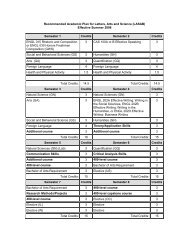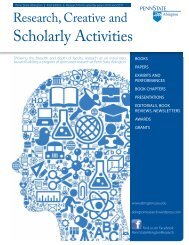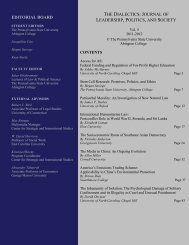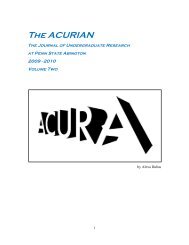Vol. III - Penn State Abington
Vol. III - Penn State Abington
Vol. III - Penn State Abington
Create successful ePaper yourself
Turn your PDF publications into a flip-book with our unique Google optimized e-Paper software.
ecame the country with the largest government legal aid system in the world (Taylor, 2002).<br />
From 2003 until now, government legal aid has continued to expand.<br />
China’s governmental legal aid system does face significant problems, however. The<br />
funding system for legal aid often leads to poorer provinces receiving substantially less money<br />
than their wealthier counterparts (Zhou, 2002). Dependent women are sometimes disqualified for<br />
legal aid because of the use of household income as a determinant as to who receives aid from<br />
the government (Huaiqing, 2008). The system of forcing lawyers to take legal aid cases pro bono<br />
in China often times leads to poor and unenthusiastic representation (China’s legal aid is<br />
multiplying, n.d.). In addition, governmental legal aid clinics are limited by the cases they can<br />
undertake. They often shy away from controversial matters. Even if they do undertake a sensitive<br />
case, they will often not represent their client in court (Kao, 2004). All of these issues indicate<br />
that the government system has not done enough to foster rule of law in China. In not providing<br />
fair and accessible services uniformly, the government is allowing the public to remain<br />
disconnected from the law.<br />
Non-governmental (NGO) legal aid organizations are also important in China.<br />
Organizations and universities both have legal aid clinics that fall under this category. As of<br />
2008, the All China Women’s Federation, an NGO, claimed to have set up 2,828 legal aid<br />
clinics; the Communist Youth League set up 1,749 local legal service centers (Huaiqing, 2008).<br />
In addition, over six prominent universities maintained legal aid clinics by the end of 2008.<br />
The first university NGO legal aid clinic in China was set up as an NGO through Wuhan<br />
University in 1992. Named the Center for the Protection of Rights of Disadvantaged Citizens<br />
(CPRDC), this clinic aimed to extend legal aid in administrative hearings to disadvantaged<br />
citizens comprised of women, children, and handicapped people (Zhou, 2002). Since that time,<br />
numerous other legal aid clinics at universities have been started including those at Beijing<br />
University, Renmin University, and Nanjing University. In addition, NGOs like the All China<br />
Women’s Federation have partnered with the government to become a prominent force in<br />
furtherance of legal aid.<br />
NGO legal aid clinics face their own problems. NGOs like the All China Women’s<br />
Federation are funded in large part by the government. Consistent government funding has<br />
enabled some NGOs to be able to establish and finance independent legal aid clinics. But direct<br />
funding by the government raises questions about whether government-assisted NGOs, like the<br />
All China Women’s Federation, are willing to challenge the state in controversial matters.<br />
University legal aid clinics, on the other hand, are often underfunded. Despite being associated<br />
with universities, university NGOs receive no money from the state or the schools with which<br />
they are associated. Most university NGOs are almost completely funded by organizations within<br />
the United <strong>State</strong>s (China’s legal aid is multiplying, n.d.).<br />
The NGO legal aid system simply has not done enough to promote rule of law in China<br />
because it can only offer limited services. The university legal aid clinics have succeeded in<br />
helping the public more fully understand the legal system, but they are only a very small part of<br />
the legal aid system. University legal aid clinics offer quality and enthusiastic legal aid as<br />
exemplified by the following accomplishments of CPRDC in 2008: servicing 2020 visitors,<br />
representing a client who won a significant case against the government, hosting delegations to<br />
other countries to examine ways to improve clinic services, and exposing hundreds of law<br />
students to legal aid (The Center for Protection for the Rights of Disadvantaged Citizens of<br />
Wuhan University, 2009). By exposing aspiring lawyers to legal aid work, they are connecting<br />
the public to the law. More importantly, these university legal aid clinics are helping to create a<br />
THE DIALECTICS ▲ 2009<br />
www.abington.psu.edu/dialectics<br />
16







